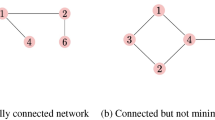Abstract
We study a group-formation game on an undirected complete graph G with all edge-weights in a set \(\mathcal { W} \subseteq \mathbb {R} \cup \{-\infty \}\). This work is motivated by a recent information-sharing model for social networks (Kleinberg and Ligett, Games Econ. Behav. 82, 702–716 2013). Specifically, we consider partitions of the vertex-set of G into groups. The individual utility of any vertex v is the sum of the weights on the edges uv between v and the other vertices u in her group. – Informally, u and v represent social users, and the weight of uv quantifies the extent to which u and v (dis)agree on some fixed topic. – For a fixed integer k ≥ 1, a k-stable partition is a partition in which no coalition of at most k vertices would increase their respective utilities by leaving their groups to join or create another common group. Before our work, it was known that such a partition always exists if k = 1 (Burani and Zwicker, Math. Soc. Sci. 45(1), 27–52 2003). We focus on the regime k ≥ 2.
-
Our first result is that when all the social users are either friends, enemies or indifferent to each other (i.e., \(\mathcal {W} = \{-\infty ,0,1\}\)), a partition as above always exists if k ≤ 2, but it may not exist if k ≥ 3. This is in sharp contrast with (Kleinberg and Ligett, Games Econ. Behav. 82, 702–716 2013) who proved that k-stable partitions always exist, for any k, if \(\mathcal {W} = \{-\infty ,1\}\).
-
We further study the intriguing relationship between the existence of k-stable partitions and the allowed set of edge-weights \(\mathcal {W}\). Specifically, we give sufficient conditions for the existence or the non existence of such partitions based on tools from Graph Theory. Doing so, we obtain for most sets \(\mathcal {W}\) the largest \(k(\mathcal {W})\) such that all graphs with edge-weights in \(\mathcal {W}\) admit a \(k(\mathcal {W})\)-stable partition.
-
From the computational point of view, we prove that for any \(\mathcal {W}\) containing \(-\infty \), the problem of deciding whether a k-stable partition exists is NP-complete for any \(k > k(\mathcal {W})\).
Our work hints that the emergence of stable communities in a social network requires a trade-off between the level of collusion between social users, and the diversity of their opinions.




Similar content being viewed by others
Notes
See also [21], where similar results are proved for another Hedonic game (that is related to the one we study in this paper), but for a stronger notion of (core) stability.
References
Angel, E., Bampis, E., Kononov, A., Paparas, D., Pountourakis, E., Zissimopoulos, V.: Clustering on k-edge-colored graphs. Discrete Applied Mathematics (2016)
Ballester, C.: NP-completeness in hedonic games. Games Econ. Behav. 49(1), 1–30 (2004)
Bermond, J.-C., Chaintreau, A., Ducoffe, G., Mazauric, D.: How long does it take for all users in a social network to choose their communities? Discret. Appl. Math. 270, 37–57 (2019)
Bondy, J.A., Murty, U.S.R.: Graph theory. Grad. Texts in Math. (2008)
Burani, N., Zwicker, W.S.: Coalition formation games with separable preferences. Math. Soc. Sci. 45(1), 27–52 (2003)
Chatzigiannakis, I., Koninis, C., Panagopoulou, P.N., Spirakis, P.G.: Distributed game-theoretic vertex coloring. In: OPODIS’10, pp. 103–118 (2010)
Chen, J., Niedermeier, R., Skowron, P.: Stable marriage with multi-modal preferences. In: Proceedings of the 2018 ACM conference on economics and computation, EC ’18, pp. 269–286. ACM (2018)
Dailey, D.P.: Uniqueness of colorability and colorability of planar 4-regular graphs are NP-complete. Discret. Math. 30(3), 289–293 (1980)
Dimitrov, D., Borm, P., Hendrickx, R., Sung, S.-C.: Simple priorities and core stability in hedonic games. Soc. Choice Welf. 26(2), 421–433 (2006)
Ducoffe, G.: The parallel complexity of coloring games. In: International symposium on algorithmic game theory, pp. 27–39. Springer (2016)
Ducoffe, G.: Propriétés métriques des grands graphes. Université Côte d’Azur, PhD thesis (2016)
Escoffier, B., Gourvès, L., Monnot, J.: Strategic coloring of a graph. Internet Math. 8(4), 424–455 (2012)
Flammini, M., Monaco, G., Zhang, Q.: Strategyproof mechanisms for additively separable hedonic games and fractional hedonic games. In: WAOA, pp. 301–316 (2017)
Gale, D., Shapley, L.: College admissions and the stability of marriage. Am. Math. Mon. 69(1), 9–15 (1962)
Hoefer, M., Jiamjitrak, W.: On proportional allocation in hedonic games. In: SAGT, pp. 307–319. Springer (2017)
Jackson, M., Wolinsky, A.: A strategic model of social and economic networks. J. Econ. Theory 71(1), 44–74 (1996)
Kleinberg, J., Ligett, K.: Information-sharing in social networks. Games Econ. Behav. 82, 702–716 (2013)
Mnich, M., Schlotter, I.: Stable marriage with covering constraints–a complete computational trichotomy. In: SAGT, pp. 320–332. Springer (2017)
Marden, J.R., Wierman, A.: Distributed welfare games. Oper. Res. 61(1), 155–168 (2013)
Myerson, R.B.: Game Theory. Harvard university press (2013)
Ohta, K., Barrot, N., Ismaili, A., Sakurai, Y., Yokoo, M.: Core stability in hedonic games among friends and enemies: Impact of neutrals. In: Proceedings of the Twenty-Sixth International Joint Conference on Artificial Intelligence, IJCAI-17, pp. 359–365 (2017)
Osborne, M.J., Rubinstein, A.: A Course in Game Theory. MIT Press (1994)
Panagopoulou, P.N., Spirakis, P.G.: A game theoretic approach for efficient graph coloring. In: ISAAC’08, pp. 183–195 (2008)
Ronn, E.: NP-complete stable matching problems. J. Algor. 11 (2), 285–304 (1990)
Sung, S.-C., Dimitrov, D.: Computational complexity in additive hedonic games. Eur. J. Oper. Res. 203(3), 635–639 (2010)
Author information
Authors and Affiliations
Corresponding author
Additional information
Publisher’s Note
Springer Nature remains neutral with regard to jurisdictional claims in published maps and institutional affiliations.
Rights and permissions
About this article
Cite this article
Chaintreau, A., Ducoffe, G. & Mazauric, D. Non-Existence of Stable Social Groups in Information-Driven Networks. Theory Comput Syst 66, 758–777 (2022). https://doi.org/10.1007/s00224-022-10089-6
Accepted:
Published:
Issue Date:
DOI: https://doi.org/10.1007/s00224-022-10089-6




